Cell division Cell and Cell Cycle:
All living organisms are made up of cells, which are the structural and functional unit of life. It is independent and self reproducing under favourable condition. Shapes and sizes ofcells vary.
A division of labour exists among the cells forming a multicellular plant or an animal body. “Omnis cellula e cellula”, means every cell is derived from a pre-existing cell.
Starting with a single fertilized egg cell (Zygote), the first division produces two cells; when these daughter cells divide, four cells are produced—thus number of cells increases called hyperplasia.
Class 10th Life Process
Interrelationship among chromosome, DMA and gene (What are hromosomes? How are they formed ?) :
Inside the nucleus of eukaryotic cell, there is thread-like intertwisted network called chromatin network. These are actually nucieoprotein threads consisting of DNA and protein.
DNA is a large biomolecule.
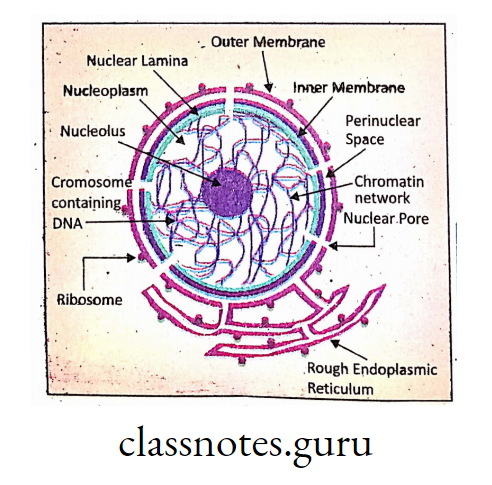
Inside the nucleus, DNA remains in partly open and partly folded condition to form the network, also known as chromatin reticulum. In the folded condition, DNA is looped tightly around proteins.
This folded structure of DNA is termed as chromosome.
Read and Learn More Class 10 Science
So the difference between chromatin and chromosome is that chromatin is unfolded, uncondensed, extended DNA while chromosomes are condensed DNA.
Chromosomes are condensed chromatin and chromatin is unfolded chromosome. Chromatin is present in a cell normally in Interphase, while the chromatin threads get condensed into chromosome during cell division.
Thus chromatin or chromatin reticulum and chromosomes are actually different folding condition of DNA molecule.
Continuity of Life: Class 10 Science Notes
Chromosome (Gr. Chroma-colour; soma—body) :
The intranuclear gene bearing, self dividing, fixed numbered, rod shaped structures which become dearly visible during metaphase and anaphase of cell division are known as
chromosomes that control all cellular activities.
Chromosome was first named by W. Waldeyer In 1888. During metaphase of the cell division the chromosomes are clearly visible and countable under compound microscope.
Class 10th Life Process
DNA double helix :
- Full form of DNA is Deoxyribo Nucleic Acid. It is usually double-stranded (double helical).
- Double helical molecular structure of DNA was first discovered by Watson and Crick (1953), for which they were awarded Nobel Prize.
- The DNA is formed of two helices or strands or chains named as a and (). Two chains are interlinked by Hydrogen bonds (H-bonds). Two chains are antiparallel. (Much details of DNA have been discovered by many scientists.)
- Each chain of DNA consists of number of structural units called deoxyribonucleotides. Hence DNA is the polymer of deoxyribonucleotides. Two consecutive deoxyribonucleotides are interconnected by phosphodiester bond.
Gene (Where are genes located ?) :
Gene is the hereditary unit consisting of a particular sequence of bases in DNA and specifying the production of distinct enzymatic protein in the cell. Gene Is the functional unit of DNA.
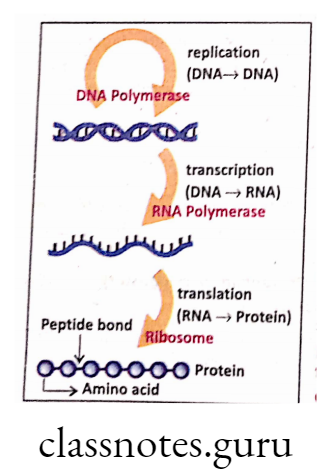
Genes are responsible for transmitting the hereditary traits from parents to offspring. Series of genes are present on each DNA.
How does gene act ?
Gene is a particular part of DNA that carries specific code. From DNA (gene) m RNA is synthesized by the process of Transcription. From m RNA specific protein Is synthesized by a process known as Translation.
This specific protein may be a structural protein or enzyme protein. The enzyme alters metabolic rate (profile) in the cell or organ of the body leading to the expression of different characters Is an organism.
Thus gene acts In the cell indirectly through the formation of enzymes.
Class 10th Life Process
Types of chromosomes: Functionally, chromosomes are of two types :
Autosome— The chromosomes that are responsible for controlling all the somatic characters of the body except sex determination are called autosomes.
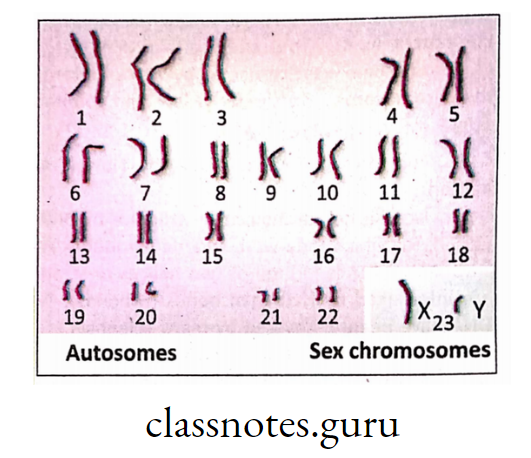
Example— in each human somatic cell,number of autosome is 22 pairs. Somatic character means height of the body, skin complexion, texture of hair etc.
Allosome (Sex chromosome)— The chromosomes that are primarily responsible for sex determination (maieness or femaleness) of an organism are called allosomes or sex chromosomes.
Example—In each somatic cell of man, number of allosome is 1 pair. In human male, two allosomes are named as X and Y whereas in human female, two allosomes are named as X and X.
So, in human female, two sex chromosomes are identical (one pair of X) but in human male, they are nonidentical—one X and one Y. X and Y differ in size and morphology.
Karyotype (type of chromosome) of human c? = 44A + XY
” ” ” ” ? = 44A + XX
Chromosome number :
The characteristic number of chromosomes present in each somatic cell of an organism which is constant for any particular species of plant or animal is known as chromosome number of that species.
e.g. chromosome number of man (2n = 46), Fruit fly (Drosophila nelanogaster) (2n = 8), Pea plant (Pisum sativum) (2n = 14), Honey Bee (Apis indica) (2n = 32).
Somatic cell (Body cell): Any cell of a multicellular organism other than the reproductive cell is called somatic cell. e.g. In human body all cells of liver, kidney, blood, brain etc. are called somatic cells.
Generally, somatic cell contains diploid (2n) number of chromosome.
Class 10th Life Process
Germ cell and germ mother cell: A cell that contains half the number of chromosomes (n) of a somatic cell and participates in fertilization of sexual reproduction is known as germ cell. e.g. sperm in male, ovum in female.
The mother cell from where the germ cell is formed is known as germ mother cell. e.g.Spermatogonia in testis, oogonia in ovary.
Diploid— When the nucleus of a cell contains two complete sets of chromosomes paternal set (from father) and one maternal set (from mother), the cell is called diploid.
It is represented by 2n. In man, diploid number of chromosome, 2n = 46, is found in the somatic cells like hepatocyte (in liver), WBC (in blood), neuron (in brain) etc.
Haploid — When a single set of unpaired chromosome is present in the nucleus of a cell,the cell is called haploid. It is represented by n. In man, haploid number of chromosome, n = 23, is found in the germ cell like sperm in testis, ovum in ovary.
Difference between haploid and diploid :
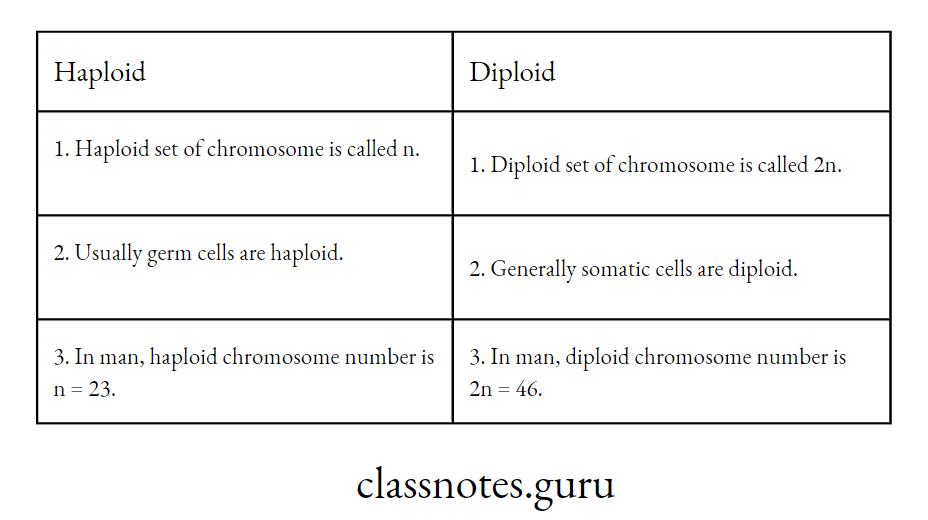
Structure of chromosome (what are the parts of a typical chromosome ?) :
Morphology of Eukaryotic rchromosome: Chromosome is microscopic threadlike structure.
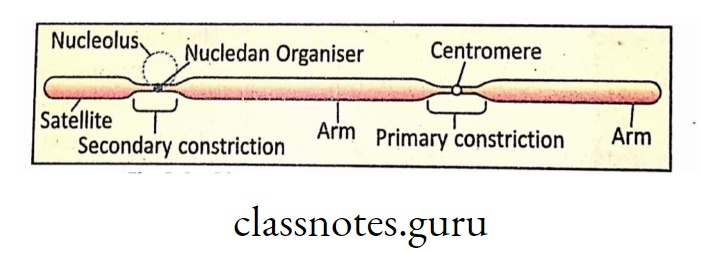
NCERT Class 10 Science Notes: Continuity of Life
Function of chromosome :
- Chromosomes are responsible for cell division.
- Chromosome contains DNA which contains genes that are responsible for inheritance of characters from parents to offspring.
- Chromosome controls cellular metabolism by the synthesis of necessary enzyme indirectly through mRNA (Central Dogma).
- Chromosome undergoes crossing over causing mutation and thus results into formation of new variation.
- Sex chromosome plays role in sex determination.
- Autosome controls all somatic characteristics of the body.

Chemical components of Chromosome :
The major chemical components of eukaryotic chromosomes are nucleic acids and proteins (basic proteins).
The nucleic acids are of two types i.e. about 45% Deoxyribonucleic acid (DIMA) and about 5% Ribonucleic acid (RNA).

DNA combines with histone, a simple basic protein, to form nucleoprotein which is conjugated protein They remain with the ratio 1:1. The RNA and acid protein vary in amount quite widely from one kind of cell to another.

Primarily chromosome contains 90% DNA + basic protein and 10% RNA + acid.protein
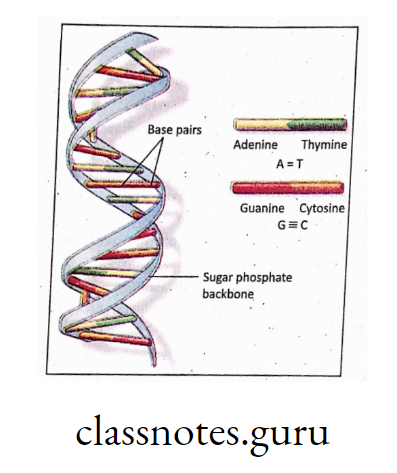
DNA:
- The full term of DNA is,deoxyribonucleic acid.
- It is usually double stranded (helical), consisting of a number of unit called deoxyribonucleotides,
- A nucleotide consists of a deoxyribose pentose sugar, phosphoric acid and a nitrogen base (purine or pyrimidine).
- The pyrimidine bases are cytosine (C), thymine (T) and the purine bases are adenine (A) and guanine (G).
- DNA molecule forms the structures called genes
RNA :
- The full form of RNA is ribonucleic acid.
- It is usually single stranded (helical).
- The structural unit of RNA is ribonucleotide.
- The pentose sugar is ribose.
- The nitrogenous bases are Adenine (A),Guanine (G),Cytosineand (C) Uracil (U).
- RNA helps in protein synthesis.
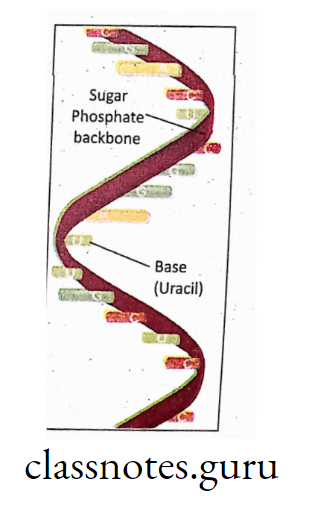
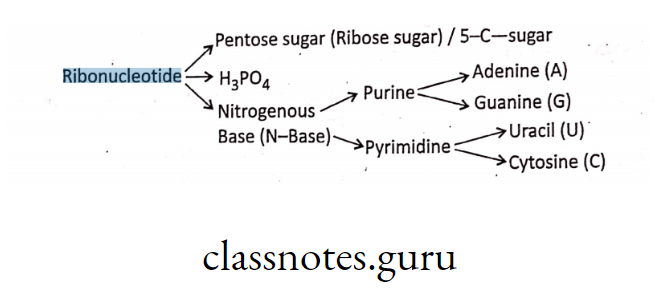
Types of RNA: Mainly RNA are of two types—Genetic RNA and Non-Genetic RNA.
Genetic RNA—Here RNA bears hereditary characters (genes) only e.g. Most plant virus and some animal virus like, influenza virus, HIV.
Non-Genetic RNA—Here DNA forms the genetic material. This type of RNA originates from the DNA of the cell and helps in protein synthesis.
They are of three types—
- Messenger RNA (mRNA)—Carries information from DNA for protein synthesis,
- Transfer RNA (tRNA)—Collects actual amino acids for protein synthesis,
- Ribosomal RNA (rRNA)—Helps in protein synthesis.
Protein: In addition to DNA and RNA, the chromatin (nucleoprotein) contains histone protein (basic protein) and non-histone protein (acid protein). The alkaline protein,histone, mainly contains amino acids like arginine, lysine, histidine, whereas, the acidic protein generally possess amino acids like tryptophan and tyrosine.
Class 10th Life Process
Nucleoside and Nucleotide :
Nucleoside—It is made up of pentose sugar molecule and a N2 base (without H3P04).
Nucleotide—It is made up of a pentose sugar molecule, N2 base and phosphate group.
Difference between DNA and RNA :
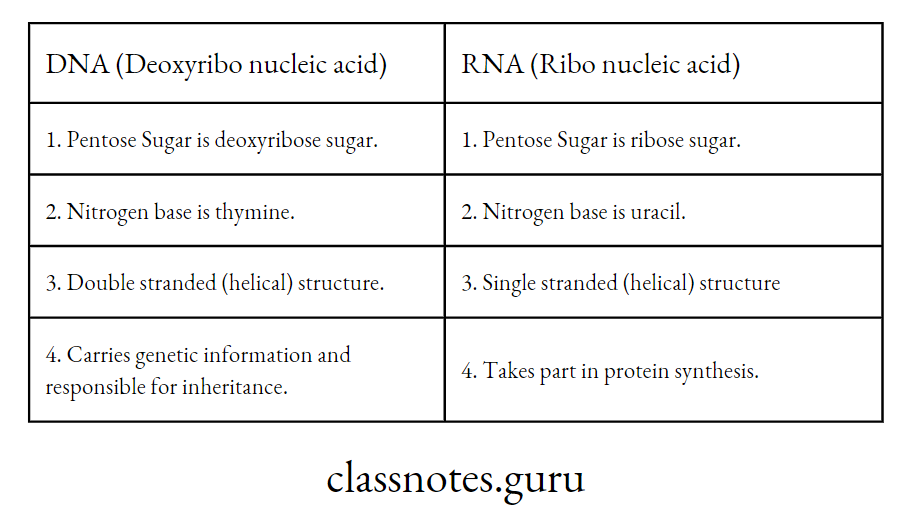
Continuity of Life: Reproduction in Living Organisms
Euchromatin and Heterochromatin :
Euchromatin—The uncoiled part of chromosome, which is genetically active in interphase is called euchromatin.

Heterochromatin—The densely coiled part of chromosome, which is genetically inactive in interphase is known as heterochromatin.

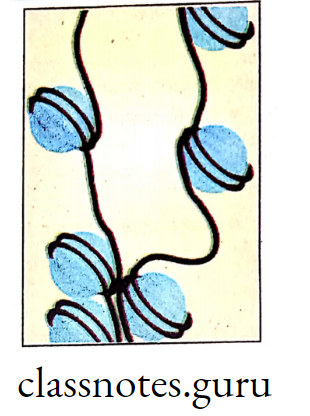
Difference between Euchromatin and Heterochromatin:
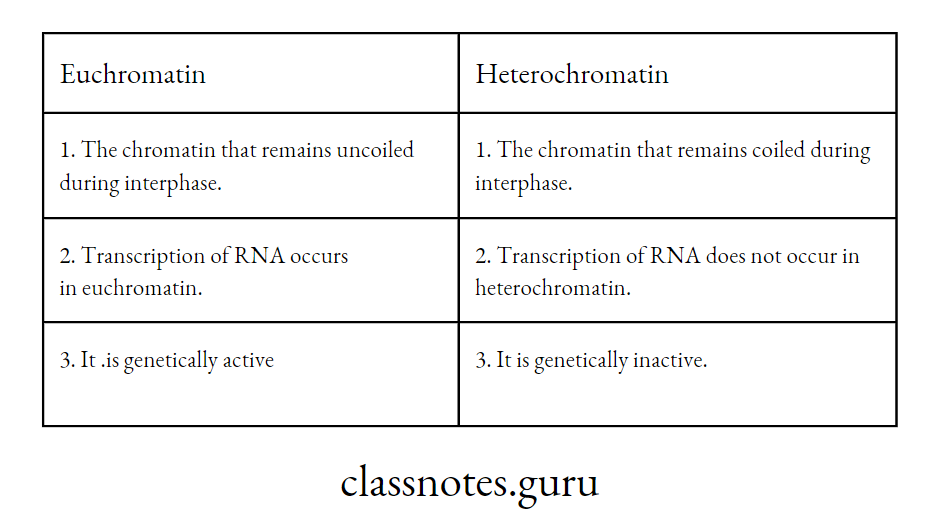
Cell organelles and structures involved in cel! division :
Cell is the smallest organised unit of living body which is self-reproducing under favourable condition.
Prokaryotic arid Eukaryotic cells:

Prokaryotic cell: The cell which lacks a nuclear envelope, nucleolus and well defined cytoplasmic organelles, such as endoplasmic reticulum, Golgi body, mitochondria, centriole, etc. is known as prokaryotic cell.
Examples—Bacteria (Azotobacter, Clostridium), Blue green algae [Nostoc, Anabdena), Mycoplasma.
Eukaryotic cell: The cell in which the nucleus has a definite nuclear membrane, nucleolus-ana well defined cytoplasmic organelles like endoplasmic reticulum, Golgi bodies, mitochondria, lysosomes, etc. is known as eukaryotic cell.
Examples— Cells of higher plants and animals.
Difference between Prokaryotic and Eukaryotic cell :
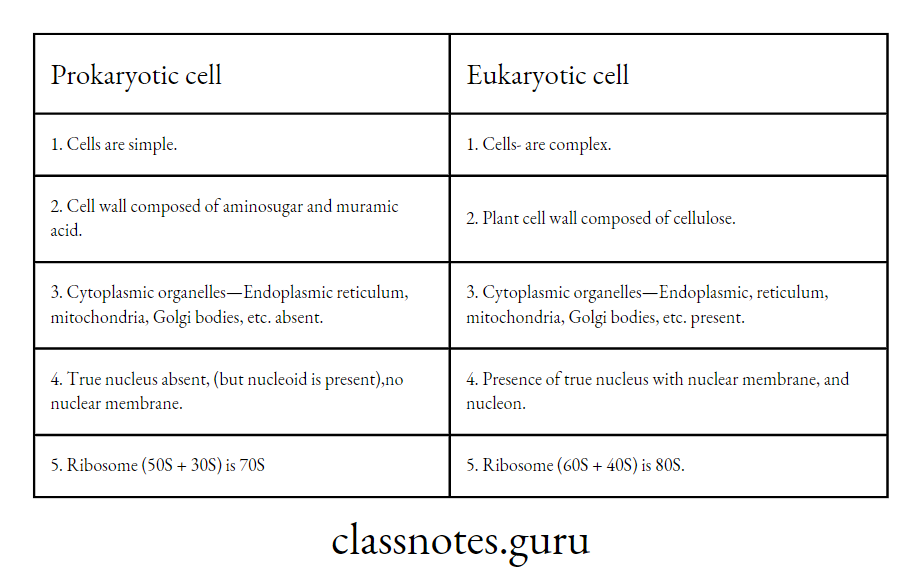
Role of cell organelles in cell division :
Some cell organelles play significant role in cell division as follows :
Nucleus—It is largest cell organelle where number of chromosomes are present in form of a chromatin network in interphase. During cell division, these chromosomes will be first divided into two chromatids and then separate chromosomes will be formed through different stages of karyokinesis. So, nucleus is the site of division of chromosomes.
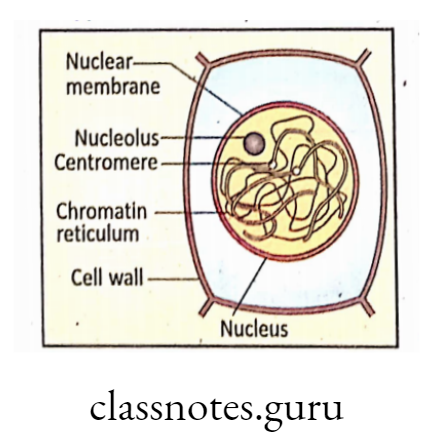
Centrosome and microtubule—Centrosome is present generally in animal cells and few exceptional lower plant cells. One centrosome consists of two centrioles,perpendicular to each other.
Centrioles are formed of nine triplet sets of microtubule (9 + 0 cart wheel model). Each microtubule is formed of tubulin protein.
During cell division, a diamond shaped structure is formed in the middle of the cell called Spindle. The spindle is made of many spindle fibres. In animal cell, these fibres are formed from centriole.
During cell division, two centrioles are separated and pushed apart to opposite poles of the cell by the elongation of spindle fibres in between them.
In animal cells, the spindle having centriole with aster at two poles is called or astral spindle or amphiastral spindle but in most plant cells, spindle withoutcentricasterspindle(astral rays) Is called as acentric spindle or anastral spindle.
So, in animal cell, spindle is formed from centriole whereas In plant cell the spindle is formed from cytoplasm and nucleoplasm.
Ribosome-This is the cell organelle responsible for protein synthesis. Huge amount Of protein is required for cell division-like tubulin for spindle fibre, enzyme protein etc. All these are synthesized by ribosome.
Mitochondria—There are Lot of metabolic functions during cell division, for which sufficient quantity of energy is required which is supplied by mitochondria.
Cell division and its significance :
The active process by which a matured mother call duplicates itself to give rise to two daughter ceils is called cell division.
Starting with a single fertilized egg cell (zygote), the first division produces two cells. These two daughter cells divide to produce four cells and so on. Thus starting from a single cell, four consecutive divisions will produce 24 = 16 cells, 10 division will produce 210 = 1024 cells.
It would require only 43 divisioin cycles to produce 5 trillion cells in the body, starting from a single cell. This increase in number of cells by cell division is called hyperplasia.
Significance of cell division :
Growth—By repeated cell division, number of cells in multicellular organism increases (hyperplasia) which results into overall growth and development of organs and body of the organism.
During embryonic growth, the first formed cell is zygote which undergoes repeated cell division to form an embryo and then into newborn.
Reproduction—Unicellular organism (like protozoa, yeast, bacteria etc.) reproduces by the process of cell divison. Mitosis helps in vegetative reproduction in plants and asexual reproduction in plants and animals.
On the other hand, meiosis helps in sexual reproduction both in plants and animals.
Repair—By cell division, old decaying dead cells are replaced by new cells. At every moment, millions of cells are dying in our body and millions of cells are forming by cell’ division to compensate the loss.
Healing of wound of an injured area is done by repeated cell division of adjoining living cells. Thus the injured area is repaired.
Class 10 Science Chapter: Continuity of Life and Reproduction
Types of cell division :
In animals and plants three types of cell divisions have been distinguished Mitosis and Meiosis.
Amitosis or Direct cell division :
The process of direct cell division in which the nucleus first constricts in the middle to divide into two nuclei and then the cell body undergoes changes without spindle formation and ultimately divides into two daughter cells is known as amitosis.
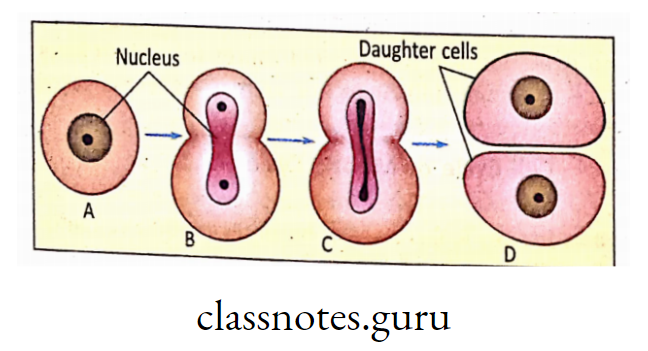
Occurrence :
- In lower plants—Chara, yeast, bacteria, etc.
- In animalsAmoeba.
Mitosis or Indirect cell division :
Mitosis is a process of equational and indirect cell division that occurs in the somatic cells of the body where a mother cell divides itself into two daughter ceils that are qualitatively and quantitatively similar to the original mother ceil.
‘Qualitatively means type of genes (genotype) and ‘quantitatively’ means number of chromosomes of daughter cells.
Occurrence: Mitosis occurs in the somatic cells of the multicellular eukaryotes.
In plants—It occurs in the growing parts like root, stem, leaves, flower buds, apical buds, embryonic buds and in cambium,
In animals—It takes place in all the somatic cells except nerve cells, sex cells and muscle cells.
Mitosis is called an equational division because, the two daughter cells (diploid or 2n) which are produced, remain identical to the diploid (2n) parent cell.
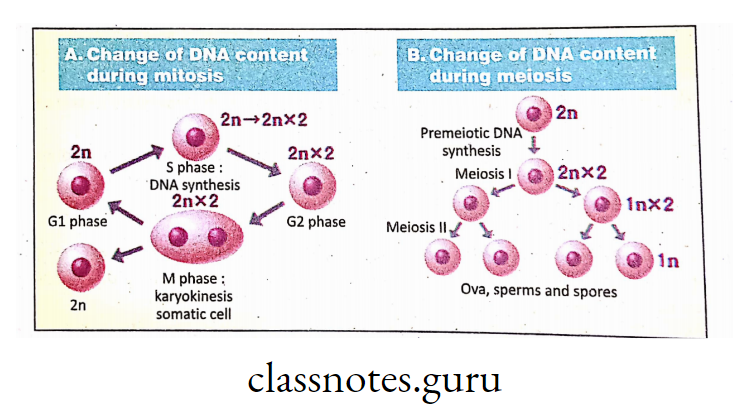
Meiosis or reduction division :
Meiosis is a process of reduction division that generally occurs in the germ mother cell where a diploid (2n) mother cell undergoes two consecutive divisions (Meiosis I & II) to produce four haploid (n) daughter cells.
Occurrence: In higher plants- Meiosis occurs in spore mother cells(2) Of anther and ovule forming four haploid spores(n). In Lower animals and plants – Meiosis takes place in zygote. In higher animals – Meiosis takes place during gemetogenesis i.e in gamete (sperm and ovum ) formation.
Cell Cycle or Mitotic Cycle :
Definition: The sequence of cyclical events and changes through which grows (by G1; S, G2, stages), becomes mother cell and finally divides to fo cells is known as cell cycle.
Phases of cell cycle: In continuously dividing cells, an individual cell pass cyclically through two main phases of cell division. Every cell cycle has a long resting phase called ‘Interphase’, followed by a short divisionary phase called ‘M’ phase.
Interphase is divided into three subphases—G1phase, S phase and G2 phase.
G1 phase—It is a phase when a cell prepares itself for division. Cell grows in size, synthesizes RNA and proteins. DNA content remains unchanged.
S phase or Synthetic phase—In this phase new DNA is synthesized on the mother DNA template. So, the amount of DNA is doubled. Histone protein is also synthesized in S phase. Each chromosome now consists of two chromatids joined at the centromere.
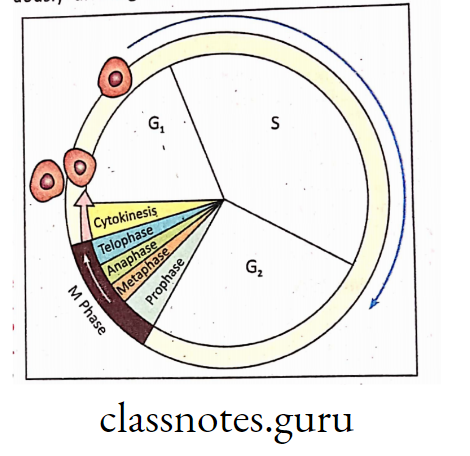
G2 phase—In this phase, cell growth, synthesis of RNA and protein continues.
Cell cycle time: The duration of cell cycle varies from one organism to another and from cell to cell. It ranges from few minutes to years. However, for fast dividing mammalian cells, the length of cell cycle is approximately 24 hours.
Significance of cell cycle :
Preparatory phase- During interphase of cell cycle (G1 S, G2) the cell gets itself prepared for cell division. There are many synthetic metabolic reactions inside the cell at this phase. This is wrongly (misnomer) called as ‘resting phase’. In fact, it is the most ‘active phase’ of cell cycle.
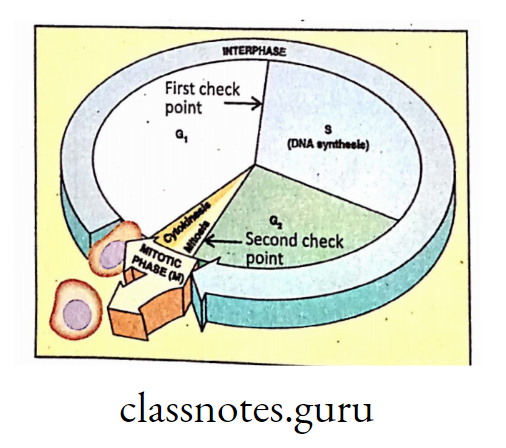
So, interphase is the ‘preparatory phase’ of cell cycle. In a pie chart of 360°, the interphase is nearly 320°-340n whereas the M-phase is approximately 20°-40°. Thus ‘preparation’ is much prolonged than that of ‘actual function’ (cell division).
Checkpoints in cell cycle—Many proteins (like cyclin etc.) and enzymes CDK (Cyclin Dependent Kinase) control cell cycle at different points called check points. First check point is in between G1 and S whereas second check point is in between G2 and M.
Thus the process of cell cycle and cell division is regulated, controlled and balanced.
Loss of control of cell cycle and formation of tumor—In our body at every moment large number of cells are dying called apoptosis. To compensate this loss, large number of cells are forming by cell cycle and cell division.
Thus a balance is maintained between ‘birth rate’ and ‘death rate’ of cell.
If the ‘check points’ in cell cycle do not work properly or if the control of cell cycle is lost,then the process of cell division and cell cycle becomes erroneous which may lead to formation of tumor. Tumor develops due to “uncontrolled cell division” (without differentiation) when a cell starts dividing at a vigorous rate.
Tumor is a type of unnatural swelling in any part of the body. This is richly supplied with blood vessels. Generally, tumor is of two major types—(a) Benign tumor, (b) Malignant tumor.
Benign tumor is noncancerous tumor. These cells do not spread over the body and remain restricted at a particular part of the body.
Malignant tumor is cancerous tumor that may result into cancer. Cancer cells (malignant cells) can spread from origin to different parts of the body called metastasis.
Mitosis :
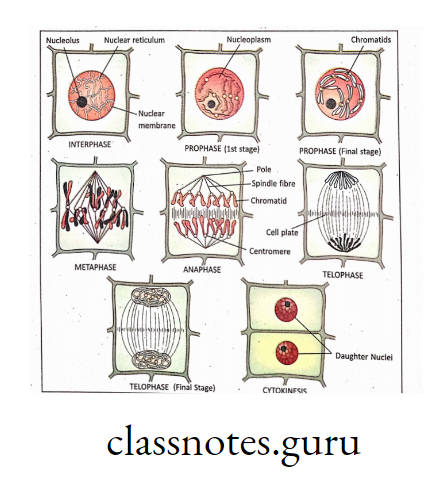
Definition: Mitosis is a process of equational and indirect cell division that occurs in the somatic ceils of the body where a mother cel! divides itself into two daughter cells that qualitatively and quantitatively similar to the. mother cell.
Characteristics of Mitosis :
- Mitosis is called equational division because the chromosome number of mother cell and daughter cell remains same in mitosis.
- Mitosis is known as indirect cell division because during this process, chromatids are pulled towards opposite side by spindle fibre. So the chromatids do not get separate themselves. Hence it is indirect cell division.
- Mitosis is called somatic cell division because this process occurs only in the somatic cells of the body.
- By this process one mother cell is divided into two daughter cells.
- The daughter cells have same chromosome number (quantity) to that of mother cell as well as same genotype (quality) like the mother cell. Hence the two daughter cells produced by mitosis are qualitatively and quantitatively similar between themselves and to the mother cell.
The process of mitosis and its different stages :
The whole process of mitosis is completed in two phases— Nuclear division (karyokinesis) and cytoplasmic division (cytokinesis).
Karyokinesis—Definition: The process by which the nucleus of mother cell is divided into two daughter nuclei through Prophase, Metaphase, Anaphase and Telophase is known as Karyokinesis.
Prophase (Gr. Pro, First) :
The first stage of mitosis during which the chromosomes condense and become visible within the nucleus followed by the dissolution of the nuclear envelope is known as prophase.
In prophase, most dramatic changes take place both in the nucleus and in the cytoplasm.
It is the longest stage of mitosis.
Important features are as follows :
- The chromosomes condense, shorten, thicken and become stainable.
- Condensation occurs due to dehydration of water from chromatin fibre.
- Chromosome is coiled by spiralisation forming series of bead like structures called chromomere.
- Each chrbmosome consists of two chromatids that are in very close association with each other all along their lenght.
- Two chromatids coil around each other and are held together by centromere.
- During early prophase,the chrbmosomes are evenly distributed in nucleoplasm but as prophase progresses, the chromosomes migrateare towards the nuclear in membrane.
- Nucleolus and Nuclear membrane gradually disappear.
- In animal cell-The centrioles duplicate and move towards the opposite poles of the cell.
- The movement of centrioles occurs due to pushing apart by growth of the spindle fibres between them. In animal cells or in the cells of lower plants, fibrils appear like spokes of wheel around each centriole to form asters. The asters are formed from cytoplasm, whereas spindle fibres are formed mainly from nuclear material.

The aster, the centrioles and the spindle together make up the structure called mitotic apparatus or achromatic figure.
Metaphase (Gr. msta, between):
The stage of mitosis during which the chromosomes attach to the spindle fibres at the centromeric region and arrange in the equatorial plane of the cell is known as metaphase.
Important features are as follows :
- A diamond shaped structure is formed during metaphase called spindle. The spindle formation starts in prophase and is completed in metaphase.
- Two pointed ends of the spindle are called as poles and central broad part is known as equator/equatorial plate/metaphasic plate.
- The spindle is formed of spindle fibres that are made of tubulin protein. There are two types of spindle fibres—
- short fibre/discontinuous fibre/chromosomal fibre—which is extended from pole to equator,
- long fibre/continuous fibre/achromosomai fibre—which is extended from one pole to another pole.
- The chromosomes begin to proceed towards the equator. They reach the equator of the spindle and line up in one plane. Maximum contraction of chromosomes or coiling or condensation takes place at this stage and the chromosomes of a particular cell are easily countable.
- The centromere is attached with the short chromosomal fibre and the arms are directed towards the poles (the arms are repelling each other).
- In plant cell, the orientation of chromatids on equatorial plate is random but in animal cell, a pattern orientation occurs when larger chromosomes are attached at the periphery of the plate and smaller chromosomes are placed at the central part.
Anaphase (Gr. ana, back):
The stage of mitosis during which the centromeres and daughter chromosomes separate and begin to move towards opposjte poles of the cell is known as anaphase.
Important features are as follows :
- It is the shortest stage of mitosis.
- The centromeres of the chromosomes divide and the two chromatids of each pair separate. After separation, they are called daughter chromosomes.
- The daughter chromosomes migrate towards the poles (anaphase movement or metakinesis) due to shortening of spindle fibres attached to the centromeres.
- Pulling causes the chromosomes to assume their characteristic V shape or L shape, etc.
- Several forces are involved for this anaphase movement of the chromosomes like jerking force, pulling force, pushing force, repulsive force etc.
Sexual and Asexual Reproduction: Class 10 Science Notes
Telophase (Gr. teio, end):
The stage of mitosis during which the chromosomes uncoil and become surrounded by new nuclear envelope is known as telophase.
This stage begins at the end of the polar migration of the daughter chromosomes.
Important features are as follows :
- This stage is reverse of prophase.
- The chromosomes uncoil and despiralise in a process (despiralisation) comparable to a reversal of prophase and gather into masses of chromatin to form chromatin network.
- A new nuclear membrane is formed around each mass of chromatin from the endoplasmic reticulum.
- Nucleoplasm and cytoplasm are rehydrated.
- Nucleolus reappears in each cell.
- Spindle fibres are gradually disorganised.
- In animal cell, astral rays disappear.
Cytokinesis :
Definition: It is the process where cytoplasm of mother cell is divided into two daughter cells after Karyokinesis. Various cell organelles (mitochondria, golgi bodies) are also distributed
between two daughter cells.
If cytokinesis does not occur after karyokinesis, then the cell will be binucleate.
In plant cell: Commonest method of cytokinesis in plant cell is known as cell plate formation. Golgi bodies (dictyosome) forms small vesicles called phragmosome containing liquid cellulose, pectin etc.
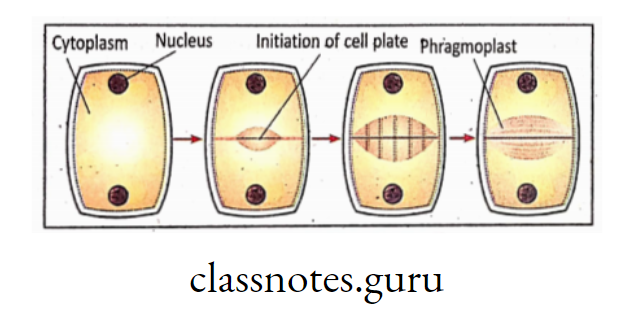
These vesicles line up at the middle of the cell and fusetogether to form a thin film of (phragmoplast) cell plate from the middle towards periphery of cell (centrifugal).
Gradually more cellulose, hemicellulose, pectin etc. are deposited on both sides of cell plate and a complete cell wall is formed separating the cytoplasm of two daughter cells.
In animal cell: Cytokinesis in animal cell occurs by the process of furrowing or cleavage or invagination. During this process, a cleavage furrow develops at the middle of the cell between two daughter nuclei.

The furrow or invagination gradually deepens towards the centre of the cell (centripetal) and fuse with each other. Thus the cytoplasm is divided into two equal halves.
Difference between Plant and Animal cytokinesis :
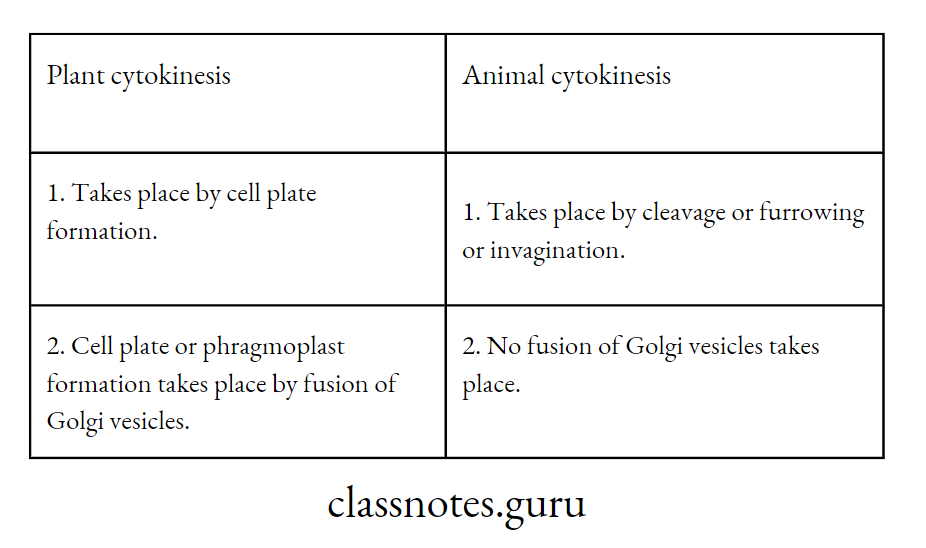
Difference between Mitosis of Plant cell and Animal cell :
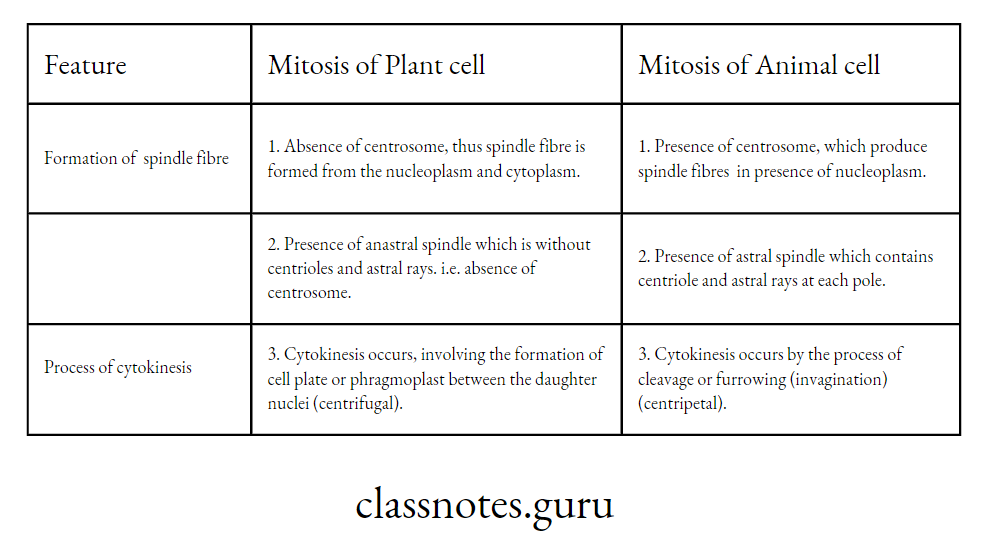
Dltiorence between Karyokinesis and Cytokinesis :

Difference between Amitosis and Mitosis :
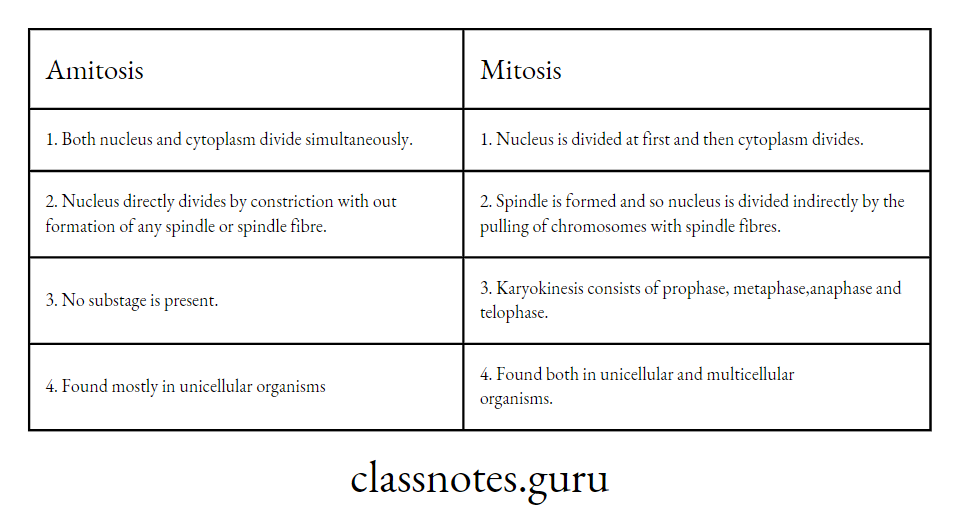
Heredity and Inheritance in Continuity of Life
Significance of Mitosis :
Growth: By repeated mitosis, number of genetically identical cells in multicellular organism increases (known as hyperplasia ), which results into overall growth, development of organs and body of the organism.
In sexual reproduction, the first formed cell is zygote (2n) which undergoes constant mitosis to form an embryo and gradually a newborn.
Cell replacement: By the process of mitosis, old decaying dead cells new are replaced by cells. For example, the skin constantly renews, itself by shedding dead cells from the surface and generating new cells from the deeper layen In most areas of the body, the epidermis has four layers and their transition from inner layer to surface layer takes place as follows :
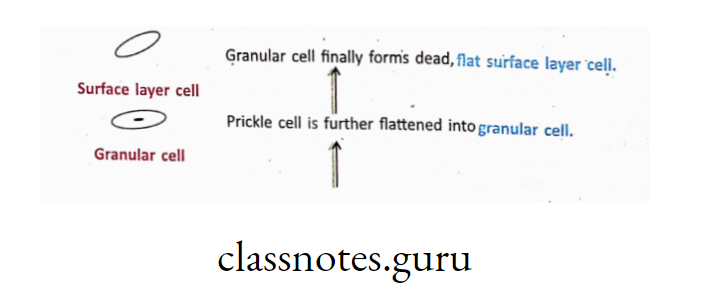
 Repair (Healing of wound): In any injured part of the body,repajr or heaiing of wound is done by repeated mitosis of the adjoining living cells.
Repair (Healing of wound): In any injured part of the body,repajr or heaiing of wound is done by repeated mitosis of the adjoining living cells.
Regeneration: Definition— It is the Process bY which some oreanisms replace or restore lost or amputated body parts by mitosis. Regeneration, of limbs occurs widely in the animals of phylum Arthropods (eg. legs in Crustacea).
This may happen naturally during moulting or removal of leg by any injury or autotomy (Spontaneous loss of body parts). Some Star fish (Phylum—Echinodermata) can reproduce asexually by breaking an arm.

Starfish is well known for its power of regeneration of lost part of the body. Moreover, a complete new animal can grow from a small fragment (e.g. Planaria). The loss of fragment from the body may be due to injury or autotomy (as in house lizard).

Reproduction: So many unicellular organisms reproduce by mitosis. Mitosis helps in vegetative reproduction in plants. Asexual reproduction in plants and animals also takes place by mitosis.
Meiosis:
Definition:The process 0f rec|U(;tion division by which a diploid (2n) germ mother cell divides twice to produce four haploid (n) daughter ceils is known as meiosis.
Characteristics of meiosis :
- Meiosis is called reduction division because chromosome number of mother cell is reduced to half in daughter cells. Thus diploid (2n) mother cell produces haploid (n) daughter cells.
- The whole process of meiosis is completed in two steps of division Meiosis I (Ml) and Meiosis II (Mil).
- One diploid mother cell produces four haploid daughter cells.
- The process of meiosis primarily helps in sexual reproduction of higher plants and animals.
- During meiosis, by crossing over there is mixture of paternal and maternal genes that results into formation of new genotype and variation.
- In higher plants and animals, meiosis occurs in gonads. So meiosis is also known as germ cell division.
Occurrence: In higher animals, meiosis occurs in testis in male and ovary in female. In higher plants, meiosis occurs in pollen mother cell and egg mother cell.
Homologous chromosome :
The corresponding paternal and maternal chromosomes that are identical in structure,size (morphology), bearing same genes or their alleles and pair with each other (synapsis) during meiosis are known as homologous chromosome.
Paternal chromosome (that is inherited from father through male gamete).
Maternal chromosome (that is inherited from mother through female gamete).
The genes present in the homologous chromosome are similar—but they may be same or may not be same.
Example—Let us consider gene for human skin complexion is white and black.
In this person, both the homologous chromosomes bear white gene for skin complexion. Both the genes indicate skin complexion (similar) and whiteness (same). So, here the genes are similar as well as same.
In this person, one of the homologous chromosome bears gene for blackness and other for whiteness. However, both the genes indicate skin complexion (similar) but black and white.
Thus, here both the genes are similar but not same. These contrasting genes in homologous chromosomes are called as allele.
Sister and Non-sister chromatid :
Sister chromatids are two identical copies of a single chromosome, that are interconnected by a common centromere.
A sister chromatid referes to either of the two identical copies (chromatids) formed by the division of a single chromosome. Sister chromatids are formed during ‘S’ phase of cell cycle and remain attached by centromere.
Two sister chromatids are separated by division of centromere during anaphase stage of mitosis and during anaphase II of meiosis.
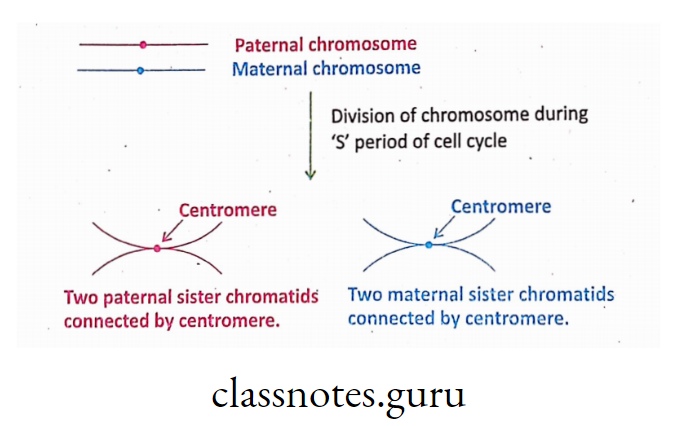
Nonsister chromatid refers to the corresponding paternal and maternal chromatid of the homologous pair.
So in a homologous pair of chromosome two paternal chromatids (produced from one paternal chromosome) are paternal sister chromatids whereas two maternal chromatids (produced from one maternal chromosome) are maternal sister chromatids.
However, any one paternal and any one maternal chromatid of the homologous pair called as nonsister chromatid.
Important features of Meiosis :
Separation of homologous chromosome : Homologous chromosomes (each having one pair of sister chromatids) are separated in Anaphase I of Meiosis I. Anaphase II of Meiosis II is, however, like mitotic anaphase.
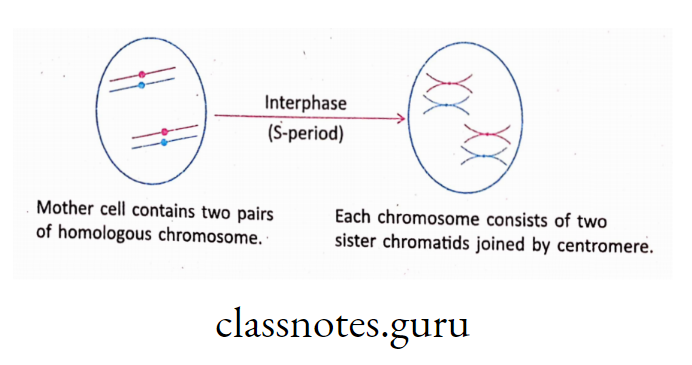
During Mitosis

In Metaphase of mitosis arrangement of chromatids in linear pattern on the’equatorial plate.
In Anaphase of mitosis, centomere of each pair of sister chromatid divides and the seprated chromatids move towards opposite poles.
During Meiosis I

In Metaphase I of meiosis,two pairs of chromatids of two homologous chromosomes (known as tetrad) are arranged on a particular point of equatorial plate of spindle.
In Anaphase ! of meiosis, centromere of sister chromatids does not divide and two chromauds move together towards one pole. Actual reducdon of chromosome number in meiosis occurs at this stage.
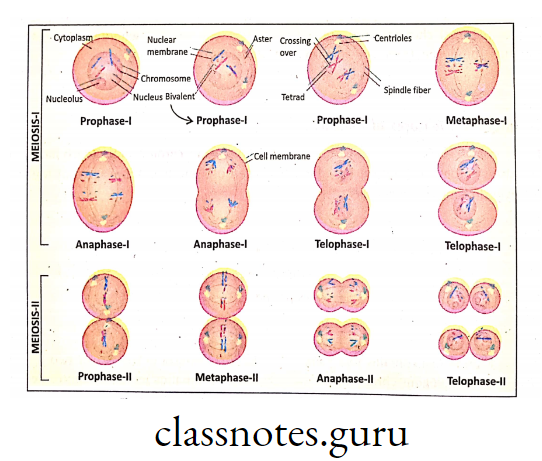
During Meiosis II
In Metaphase II of meiosis, only one pair of chromatid is arranged on a particular point on equatorial plate of spindle.
In Anaphase II of meiosis, centromere of sister chromatids divides and two chromatids are separated. This is exactly like mitosis
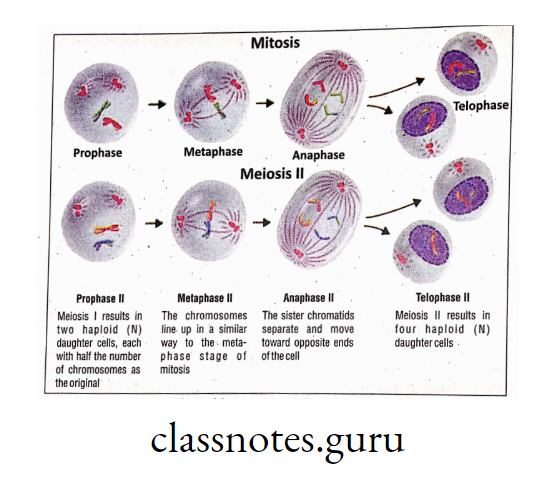
NCERT Class 10 Science: Continuity of Life and its Mechanisms
Reduction in chromosome number: During meiosis, chromosome number of mother cell is reduced to half in daughter cells. So, one diploid (2n) mother cell produces four haploid (n) daughter cells.

Crossing Over: Definition- During pachytene stage of prophase I Of meiosis , nonsister chromatids of the homologous chromosome may exchange their segments (genetic material) reciprocally known as crossing over.
So, there may be mixture of paternal and maternal genes that will result into a new genotype which is partly paternal and partly maternal. However, crossing over is a matter of chance that may occur or may not.
Crossing over of nonsister chromatids results into an ‘X’ like structure called chiasma. Hence crossing over is the cause and chiasma is the effect.
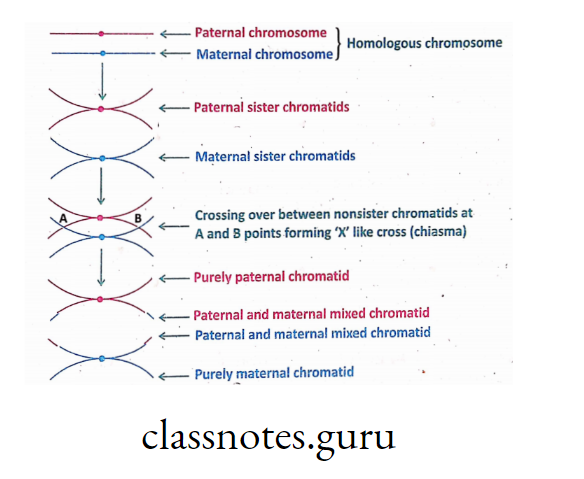
Significance of Meiosis :
Maintenance of constant chromosome number of a species—By the process of meiosis, chromosome number of higher plants and animals (who reproduce sexually) is maintained constant.

From the above chart, it is clear that during meiosis, chromosome number of mother cell (2n) is reduced to half in gametes (n). So, haploid sperm and ovum are formed.
During fertilization (syngamy), two haploid sperm and ovum unite together to form diploid zygote (2n). Hence in meiosis, chromosome number is reduced where as in fertilization, chromosome number is doubled.
That’s why, meiosis is regarded as a compensatory mechanism opposite to syngamy or fertilization and thus constant chrbmosome number of a species is maintained.
Production of variation in organisms—During meiosis, there may be crossing over between nonsister chromatids which results into “shuffling and reshuffling” of paternal and maternal genes. Thus new genotypic variation may occur in the organisms.
Formation of gametes—In higher plants and animals, meiosis takes place in diploid germ mother cells (2n) to produce haploid gametes (n). The process is known as gametogenesis.
Haploid male and female gametes fertilize to form diploid zygote.
Alternation of generation—Meiosis helps in alternation of generation as follows :
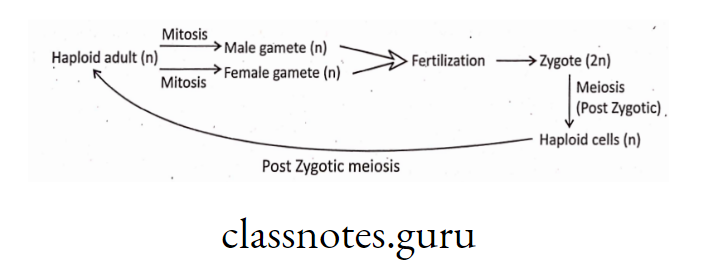
- In haplontic alternation of generation, meiosis occurs in diploid zygote to form haploid adult e.g. Spirogyra. This is called post zygotic meiosis.
- In diplontic alternation of generation, meiosis occurs during gametogenesis to’ form haploid gametes e.g. all higher plants and animals. This is called gametic meiosis or prezygotic meiosis.
- In haplodiplontic alternation’ of generation, meiosis occurs in diploid spore mother cell to produce haploid spores e.g. Fern, Moss. This is known as sporic meiosis.
Continuity of Life: Reproductive Health and Process
Difference between mitosis and meiosis :
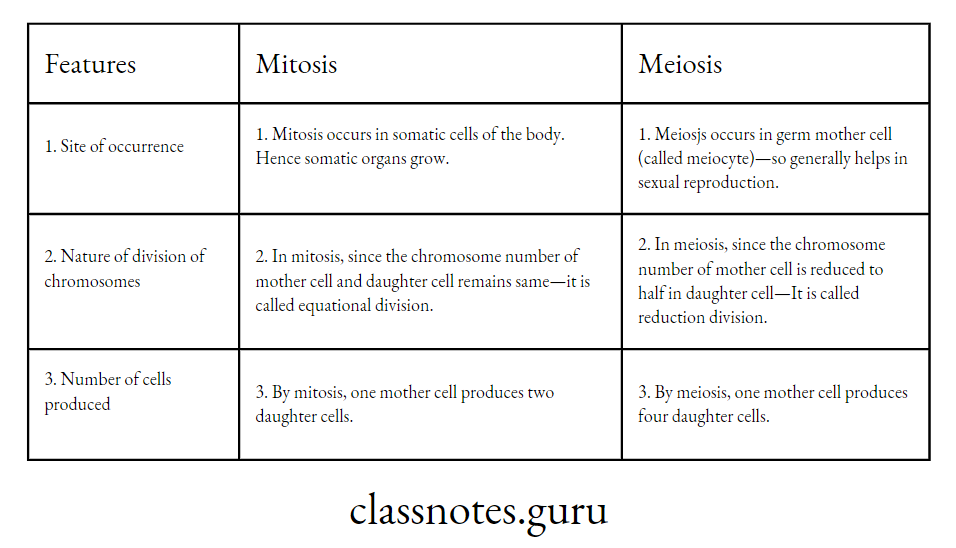
Reproduction:
Concept of reproduction (Why is reproduction necessary for an organism?)
Reproduction is the production of a new generation of individuals of the same species. It is one of the most important fundamental characteristic of living organisms. By this process they can reproduce new individuals like ownself in order to maintain the continuity of the species and also to increase in number (multiplication).
Definition: Reproduction is the process of multiplication by which living parental organisms produce offsprings of its own kind by the transfer of genes.
Importance of reproduction :
Living organisms increase in number (multiplication) by reproduction.
By reproduction living organisms maintain the continuity of generation and race.
After a certain span of life, each organism will die. To compensate this loss, there must be new birth by reproduction. Thus death rate (Mortality) and birth rate (Natality) should be balanced.
The existence of living organisms on earth will be endangered if they are incapable of reproducing new ones.
For example, Dinosaurs are extinct from earth now. Why ? There are many theories about this. But what was the exact cause—cannot be concluded.
However, one thing is obvious—that due to some reason or other Dinosaurs failed to reproduce and the eggs did not hatch. Thus due to stoppage of reproduction, Dinosaurs were perished from earth.
Modes of reproduction :
General mode of reproduction in plants and animals is asexual and sexual.
Asexual reproduction: Definition—The process by which reproduction takes place without fusion of gametes is called asexual reproduction. Asexual reproduction occurs in both plants arid animals.
For Example—In animals, asexual reproduction in hydra by budding; in plants, spore formation in moss, fern, fungi etc.
Characteristics and Importance :
- It is the process by which offsprings arise from a single parental organism and inherit the genes of that parent only.
- It does not involve the fusion of gametes.
- Many offsprings can be produced from an individual parent.
- This is a simple and easier method of reproduction.
- This method may help an individual to regenerate.
- It also helps an organism to overcome unfavourable conditions.
Sexual reproduction: Definition—The process of reproduction which involves the fusion of unicellular units called gametes to develop genetically distinct offsprings is called sexual reproduction. Sexual reproduction occurs in both plants and animals.
For Example—Pollination and fertilization in higher plants; in animals, fertilization of sperm with ovum to form zygote.
Characteristics and Importance :
- During sexual reproduction, there is union between haploid (n) male and female gametes resulting production of diploid zygote (2n).
- By this process, genetic variations or diversity may be observed among the offspring.
- Alternation of haploid (n) and diploid (2n) phase may occur in the life cycle.
- This is more efficient method of reproduction.
Vegetative Propagation (How do plants reffroduce by vegetative means?):
The reproduction by ‘which daughter plants are produced simply from the vegetative parts of a plant is called vegetative reproduction. Higher plant body consists of vegetative parts (root, stem and leaf) and reproductive parts (flowers, fruits and seeds).
Characteristics and Importance :
- Vegetative reproduction is simple and rapid method of reproduction. New daughter organisms are produced from the already existing forms.
- Daughter individuals resemble their parents.
- Chances of survival is more.
- Good quality individuals can be obtained easily from good parental varieties.
- Artificial vegetative reproduction helps in improvement of plants in terms of quality and quantity.
Types of vegetative reproduction :
Vegetative reproduction (vegetative propagation) or multiplication is basically a special type of asexual reproduction in plants. This may be natural or artificial.
Natural methods of Vegetative Reproduction :
It is the process of reproduction which occurs naturally by any vegetative (somatic) part of the plant body. Generally, vegetative part means root, stem and leaves in higher plants.
Some common examples are as follows—
Root: In sweet potato (Ipomea batatus), adventitious buds are
M produced from the root of the plant, that develop into new plant.
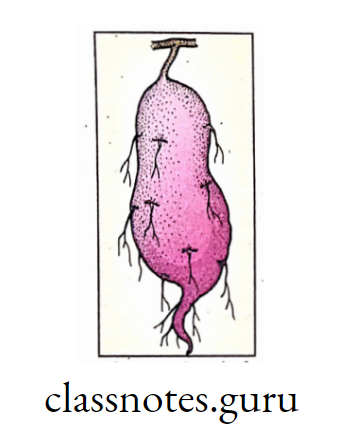
Stem: Water hyacinth (Eichhornia) is floating aquatic plant. It develops a short, thick, spongy, horizontal branch from the axil of leaves,known as offset. It is, in (Ipomea). fact, a small internode in between two consecutive nodes.

Each node bears a rosette of leaves above and a tuft of roots below. The offset often breaks away from the mother plant and develops into a separate daughter plant.
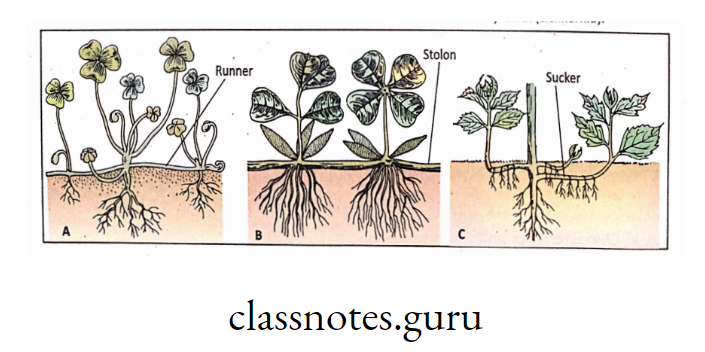
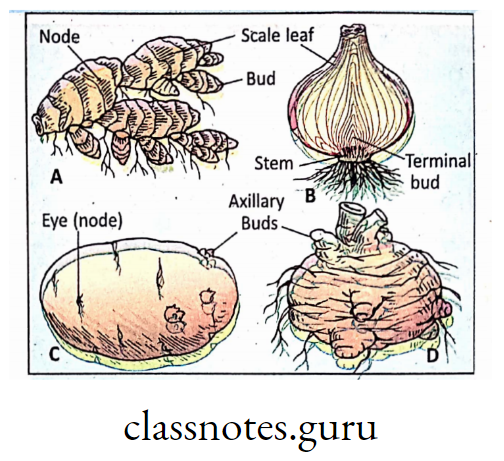
Reproduction and Continuity of Life: NCERT Class 10 Explanation
Leaf: In Bryophyllum, a series of adventitious buds’are formed on leaf margins, which usually develop into new plants.
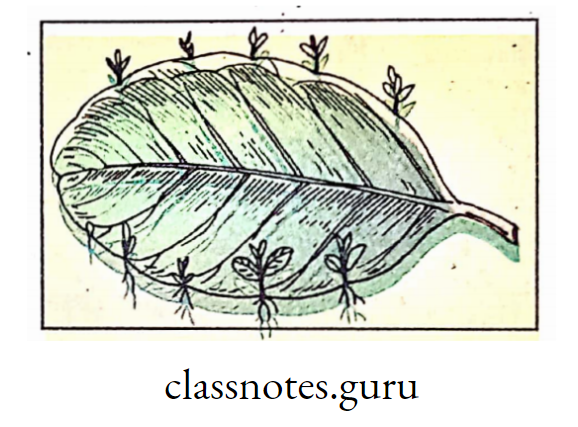
‘Artificial method of Vegetative Reproduction’:
It is the pruuÿss of reproducuon (Vegetative Propagation) where a plant part is removed from the mother plant and placed in a suitable environment so that it can grow into a whole new plant, which is genetically identical to the parent.
This process is usually practised for the reproduction (propagation) of those plants which produce either very few seeds or do not produce any viable seeds. There are various artificial methods like Cutting, Grafting, Layering, Gootee (Air layering) etc.
Cutting: It is commonest artificial method of vegetative reproduction practised by man. mature stem of a plant bearing nodes and lateral buds can be cut and planted in moist soil.

After few days new roots develop from underground cut end and the cutting becomes a new plant. Root formation at underground cut end is stimulated by treatment Of plant hormone like IAA,IBA,NAA etc.
Now-a-days, many plants are raised by stem cutting like sugarcane, banana/pineapple, orange, grapes, rose,chinarose etc.
Gafting : Definition-It is the process of artificial method vegetative reproduction where the cutting of desired variety of plant (called scion or graft) is transplated on another rooted plant (called stock).
After few days the cut ends of two different plants of the same species) fuse by their tissues to become a single, unit. The fused unit starts forming shoots and grows into a new plant, e.g. mango, litchi, guava etc. In these plants, grafting is done for preservation of original characters of the scion parent.
Micropropagation: The production of large number of individual plantlets (genetically identical to parent) from a small piece of parental plant tissue, cultured in proper nutrient medium is called micropropagation.
Basically, micropropagation is the propagation of plants by tissue culture. This process is used for propagating plants like Orchids, Dahlia, Chrysanthemum etc.

Outline of the process :
- In this process, a small piece of tissue of a desired plant is cut known as explant.
- The explant is placed in suitable nutrient medium (culture medium) which contains added nutrients, plant hormones particularly Auxin and Cytokinin.
- The tissue (explant) grows into an unorganised mass known as callus. Since tissues are cultured, it is also known as tissue culture.
- Small part of this tissue is put in another medium which induces formation of very small plant, called plantlets.
- The plantlets can be transplanted in soil or pots for further development.
Significance (Importance/Application) :
- This process ensures rapid production of desired varieties of plant.
- This method allows us to grow whole plant from cells or tissues collected from different parts of the plant body.
Alternation of generation : In the life cycle of some plants and animals, the phenomenon of alternation of two generations asexual or sporophytic or diploid and sexual or gametophytic or haploid,in a cyclic manner is called alternation of generation e.g. Fern, Moss etc.
Example of alternation of generation from Fern :
- There is distinct alternation of two generations in the life cycle of Fern (Dryopteris)—asexual / sporophytic / diploid and sexual / gametophytic / haploid.
- The adult plant body represents sporophytic generation whereas the prothallus represents gametophytic generation.
- The adult sporophyte has sporangium which contains diploid spore mother cell (2n) that undergoes meiosis to produce haploid spores (n).
- Haploid spores (n) germinate to give rise to haploid gametophytic plant (n). Gametophyte contains male reproductive organ—Antheridium (n) and female reproductive organ—Archaegonium (n).
- Both Antheridium and Archaegonium produce haploid male gamete (sperm or antherozoid) and haploid female gamete (egg) respectively by mitosis.
- The sperm (n) and egg (n) unite together (oogamy) to form oospore (2n)—which develops into adult sporophytic plant (2n).
- The sporophyte and gametophyte possess different chromosome numbers. In sporophyte, it is diploid (2n) and in gametophyte, it is haploid (n). The reduction in chromosome number during spore formation marks the beginning of the gametophyte (n), whereas, the fertilization between male and female gamete restores diploid (2n) number of chromosome and initiates sporophytic generation (2n).
- Hence, alternation of generation in Fern is primarily operated by diploid and haploid chromosome number.
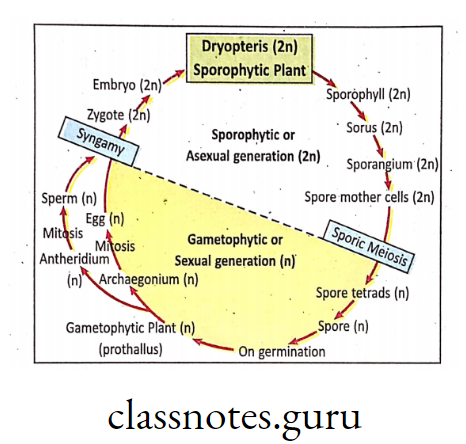
Sexual Reproduction in Flowering plants: (How does reproduction occur in flowering plants ?)
Flower Is sexual reproductive structure 6f plants, especially in angiosperms. It is modified reproductive shoot and helps in sexual reproduction of plants. It consists of thalamus on which four sets of floral whorls are arranged in orderly manner.
The arrangement of flower on the floral axis is called Inflorescence or Anthotaxy.
Different parts of a typical flower :
A typical flower consists of a thalamus with four sets of floral leaves—Calyx, Corolla, Androecium and Gynoecium that are successively arranged.
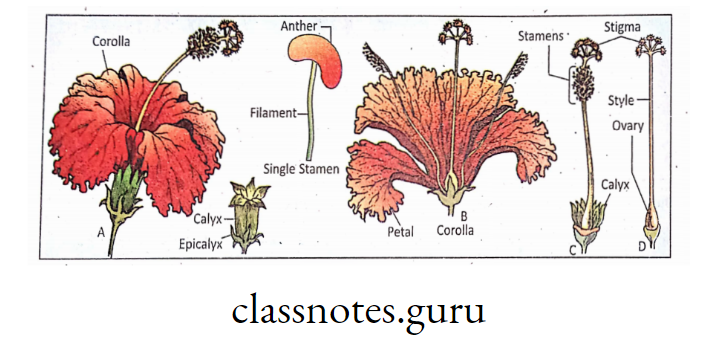
Calyx: It is the outermost part of the flower and consists of some green leaf like structures known as sepals.
Function—Sepals protect the inner parts of flower in bud condition from heat, cold, rain etc.
Corolla: It is the second inner floral set, consisting of several leafy structures called petals. Generally they have bright colour or beautiful smell or both. Function-Petals protect the inner Androecium and Gynoecium.
Androecium: It is the third inner floral whorl consisting of a number of male reproductive organs known as stamens. Each stamen consists of a slender stalk called filament and a saclike structure at the top of the filament, known as anther (pollen sac).
The pollen sac produces pollen grains that are commonly yellowish in colour.
Function— Anther of stamen produces male reproductive units of flower called pollen grains.
Gynoecium or Pistil: It is the innermost whorl of the flower. It consists of one or more female reproductive part known as carpel. Each carpel consists of a receptive terminal portion called stigma, a long slender stalk. called style and a swollen basal portion called ovary.
Ovary contains one or more ovule and each ovule contains an egg cell.
Function- The egg cell of ovule is the female gemete that helps in fertilization. After fertilization, overy is modifies into fruit and ovule is modifies into seed.
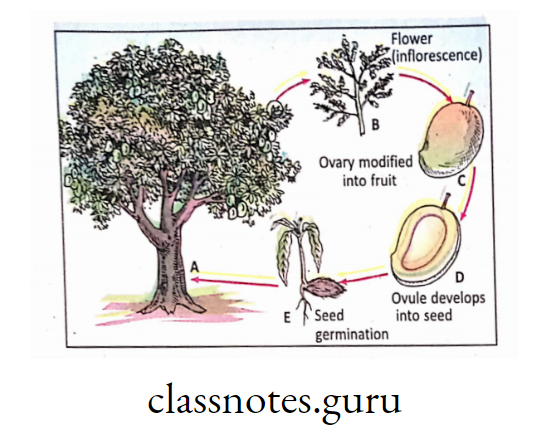
Pollination:
The flowers mature in due course of time when matured pollen grains are transferred from the anther to stigma. Fertilization does not occur until pollination takes place.
Definition
The transfer Of Pollen grains from the anther of the stamen to the stigma of carpel of the same flower or of a different flower of same species is called pollination.
A Types of Pollination :
Pollination is of two types- Self pollination or Autogamy and Cross-pollination or Allogamy.
Self-pollination of Autogamy: When the pollen grain is transferred from anther of one flower to the stigma of the same flower, it is called self-pollination. Self-pollination generally occurs in bisexual flower, e.g. Pea, Soyabean, Orchid, Sunflower, Wheat, Rice, Barley, Oats,Tomato, Potato etc.
Cross-pollination or Allogamy: When the pollen grain is transferred from anther of one flower to the stigma of another flower of a different plant (but of same species), it is called cross-pollination. Unisexual flowers are always cross-pollinated. Some common plants performing cross-pollination are apple, grapes, maize, orchid, guava etc.
Merits and demerits of self and cross-pollination:
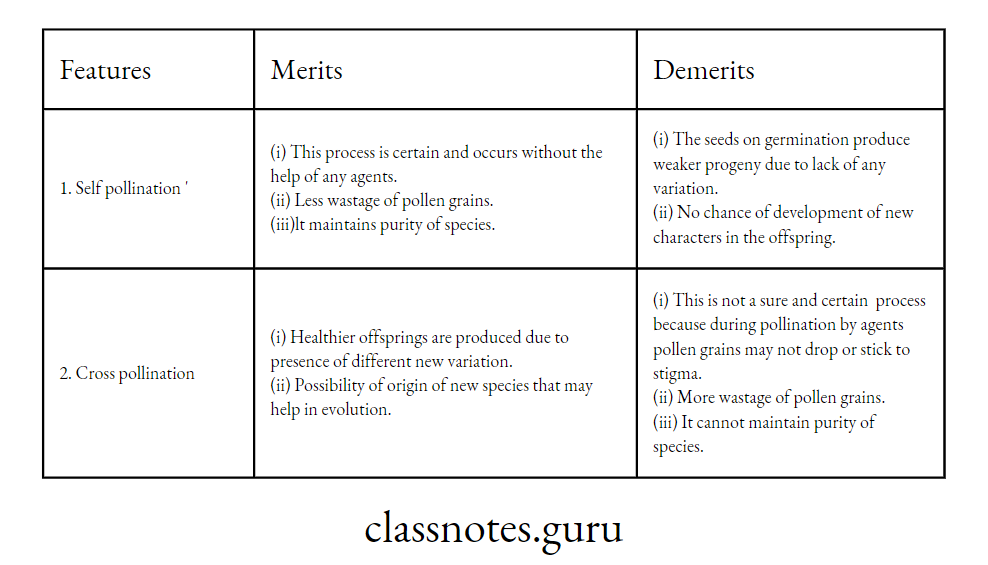
Continuity of Life: Key Concepts, Terms, and Definitions in Class 10 Science
Various agents of pollination with common example :
Agents of- pollination. The process of pollination requires agents (pollinators) that carry or move the pollen grains from the anther to stigma. Some common agents of pollination in flowers are—
- Biotic pollination (by organisms)—Pollination by insects, birds, bats, etc.
- Abiotic pollination (by nonliving substances)—Pollination by water, air etc.
Fertilization and Development of a Mew plant : (How is a new plant produced ?)
The process of union between two dissimilar haploid gametes (anisogametes) is known as fertilization or syngamy,
During fertilization male gamete (n) and female gamete (n) unite together to form diploid zygote (2n). The zygote undergoes repeated mitosis to form an embryo (2n) which gives birth to the adult plant after germination.
The sequence of events can be explained as follows :
Polination-ln this process pollen grains are transferred from anther to stigma. There is a method of selection by which the stigma selects a particular pollen grain of matchingtype.
Formation of male germ cell—Pollen grain produces haploid male gamete which passes down the style through the pollen tube. Male gamete enters the ovule in the ovary.
Formation of Female gamete—Haploid female gamete or egg is formed in the embryo sac of the ovule.
Fertilization –The haploid male gamete (n) unites with the haploid egg (n) in the embryo sac of ovule to form a diploid zygote (2n).
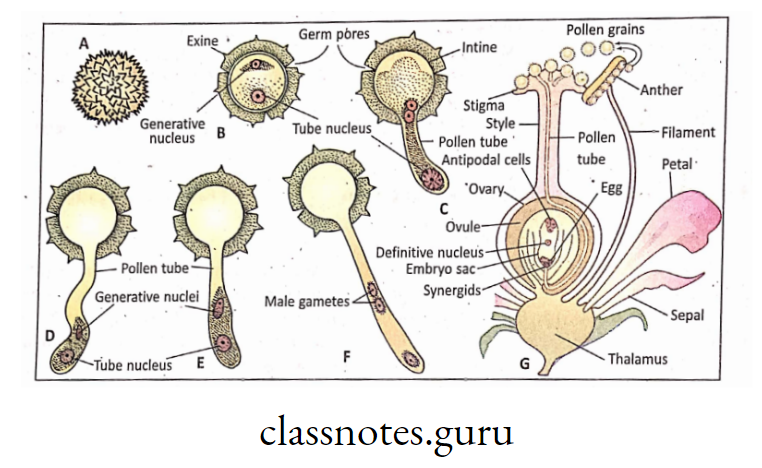
Division of zygote to form embryo—The diploid zygote undergoes repeated mitotic division to form diploid embryo within the ovule.
Formation of fruit and seed—After fertilization inner ovule is gradually modified into seed and outer ovary is modified into fruit.

Seed contains the futyre plant—Seed contains the embryo which is the future plant. Under appropriate conditions (in presence of proper quantity of water, air and sunlight), the embryo germinates into a seedling which grows into complete plant in course of time.
Growth And Development
Concept of growth (How does an organism grow ?) *
Growth Is a fundamental characteristic of all living organisms. This process Is complex In nature and regulated by protoplasm. Growth Is expressed by a permanent irreversible increase in length and volume.
A dry cork when soaked In water Increase In volume due to absorption of v/ater but it returns to original state on dehydration. Hence, the volume of cork v/as Increased temporarily which should not be referred to as growth.
Moreover, the dry weight of cork has never been changed. Here the cork Is formed of dead cells and the increase in volume is not controlled by protoplasm. In facts, most conspicuous sign of growth is an increase in dry weight accompanied by an increase in size and volume of the living o ganism.
Growth is an outcome of some metabolic processes, some of which are anabolic and some are catabolic In nature. When anabolism exceeds over catabolism, then growth takes place. Once growth occurs in a living body, it can not be reversed.
Development:Definition: Development can be defined as the increase in series of progressive, nonrepetitlve, organized changes complexity) through cellular differentiation and growth by which multicellular living organism is formed from the zygote.
Phases of growth :
The life of a multicellular organism starts from zygote (2n) which is formed bythe union of haploid male and female gamete.
The zygote grows through three distinct phases as follows:
Cell division—It is the process of increase in cell number (hyperplasia) as a result of repeated mitotic cell division. In plant body, meristematic cel! divide mitotically to form innumberable daughter cells.
In animals, zygote divides to produce bunch of cells (moruia) which form biastula, gastruia and other progressive embryonic stages.

Cell enlargement—It is the process by which daughter cells produced by mitosis enlarge both in length and volume (hypertrophy). This is mainly due to increased rate of anabolism than catabolism. The cells take in more water resulting into higher turgor pressure. At the same time,’various biomolecules are synthesized in the cells (anabolism) resulting into increase in dry weight of protoplasm
Cell differentiation—In this phase, full I grown cells are genetically differentiated to form various tissues that carry out diverse functions. So, during cell differentiation, a common type of cell becomes more specialized for a specific function.

In plants and animals, growth of the somatic organs is called somatic growth and that of reproductive organ is called reproductive growth. Somatic growth in plants is the growth of root,stem, leaf etc. whereas in animals, somatic growth is the growth of heart, lung, liver, muscle m and all other organs.
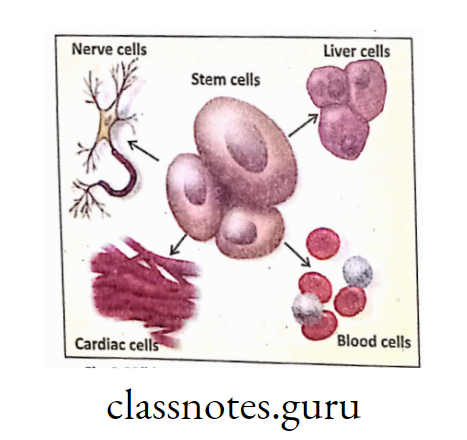
Reproductive growth in plants is the growth of floral bud, flower, fruit, seed animals reproductive growth signifies growth of testis in male and ovary in female
Several factors influence growth in both plants and animals—c.g. Internal factors {nutrition, enzyme, hormone, genes) and External factors (water, food, etc.)
Phase of human development :
There are five phases of human development—
- Infancy
- Childhood
- Adolescence (puberty)
- Adulthood
- Senescence.
Infancy—
- An infant in the very young offspring of man, usually since birth upto 2 years, unable to walk properly, early stage of growth and develop-ment.
- A great deal of initial learning occurs at this stage through parental behaviour and surrounding environment.
- They depend on adult to care for them.
- They use all sense organs for seeing, hearing, tasting, smelling and touching.
- They begin to sit up, crawl and walk.
- All the organs of the body grow at a very fast rate at this phase.
Childhood —
- Generally a child is of age 3-12 years of which 3-6 years is known as early childhood and 7-12 years is called middle age childhood.
- Tremendous growth of neural fibres occurs’in brain,
- At 5 years of age, the children speak properly with correct coordination of nervous system.
- Large muscle for walking,running and other physical activities develop well.
- Many psychological development start and the child repeatedly asks “why” ?

Adolescence—
- The term adolescence is derived from the Latin word ‘Adeloscere’, which means to grow maturity. It is a critical stage of development which lies between later childhood and maturity (emerging from the critical childhood stage and of merging development into adulthood).
- This stage is usually at the age of 12-18 years. However, there are differences due to sex, climate, genes and individual constitution.
- There is very rapid growth at this stage but rata of growth differ in boys and girls.
- A significant increase in the growth of reproductive organs is observed.
- Many biological, psychological and emotional characteristics develop like sex-consciousness, self-consciousness, imaginative activity, etc. They often focus on friendship and romantic relationships. A|! these chanSes are called secondary sex characters.
- Spermatogenesis in males and oogenesis in female start at this stage—so the reproductive system becomes functionally active (Sexual maturity).
- Masculine characters in males and feminine characters in females become prominent.
Often, puberty and adolescence are used synonymously. However, puberty refers to physical changes adolescence’s Period of psychological and social transition between childhood and adulthood. Puberty is the process of bodily changes by which adolescent reaches sexual maturity.
Heredity and Inheritance in Continuity of Life
Adulthood—
- Biologically, an adult is a human being who has achieved sexual maturity and becomes independent and self-sufficient.
- On average, the age is 20 years + 1
- All primary and secondary sex characters are very well developed in both male and female with high level of secretion of GTH.
- All somatic organs of the body are also fully developed.
Senescence (Late adulthood)—
- The word senescence has been derived from the Word ‘senescere’, meaning ‘to grow old’. can reÿer to cellular senescence or senescence body.
- It is the natural condition or process of gradual deterioration of the body’s structure and function due to aging/ when the cell loses itsÿ power of division and growth. Hence, senescence is the outcome of aging i.e., aging is the cause and senescence is the effect.
- This process occurs generally after 60 years of age.
- Senescence ultimately leads to death.
